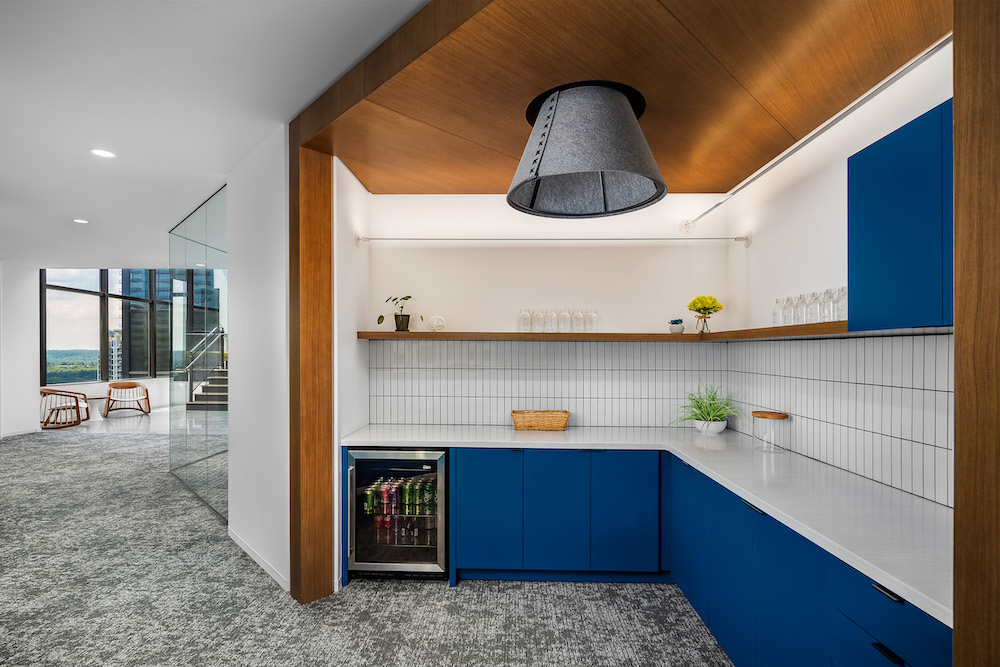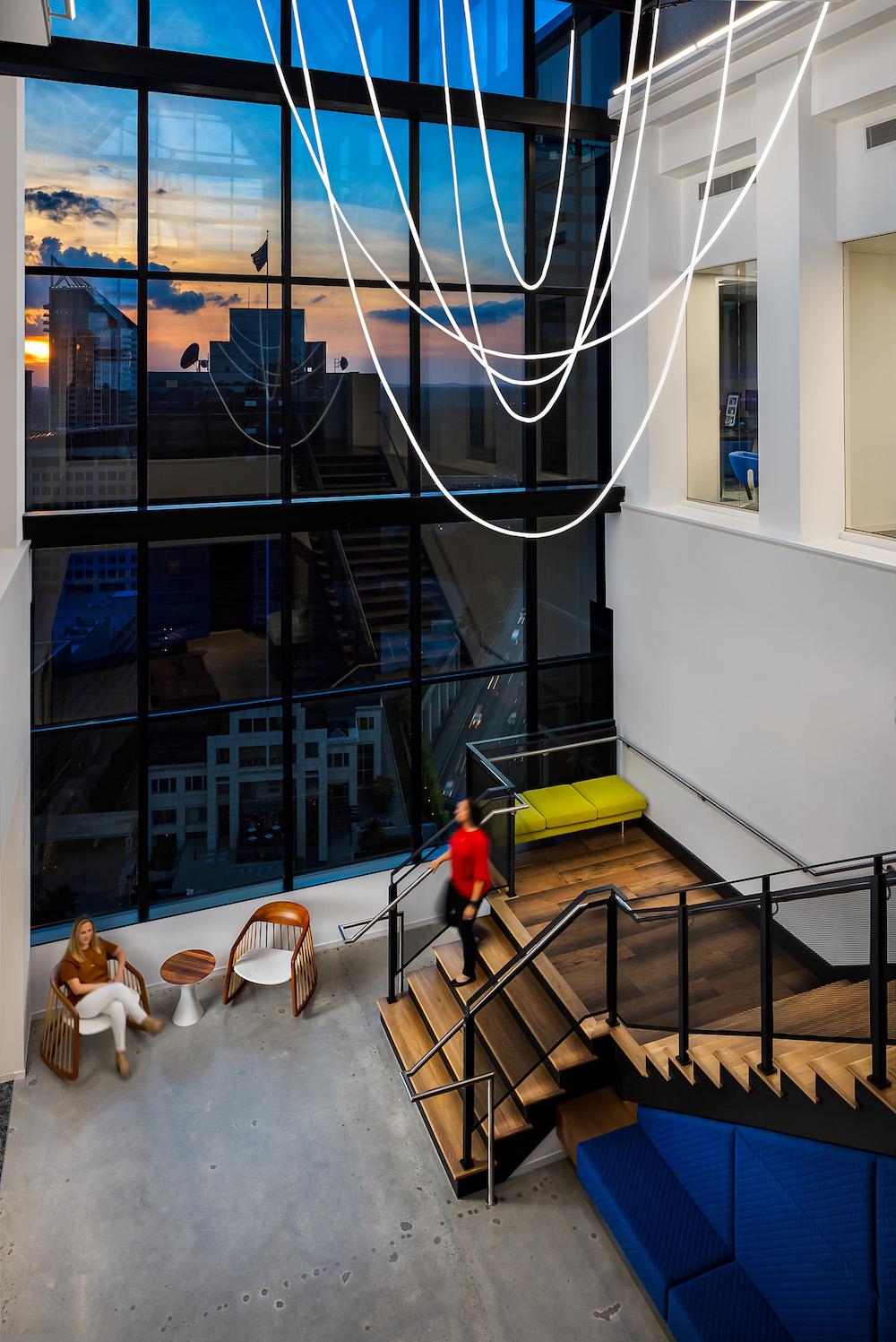Take a tour of the new Cooper Carry-designed Transwestern offices that infuses hospitality into the workplace.

Destination workplaces are emerging as a way to motivate employees and get them excited about returning to the physical office. The new Cooper Carry-designed Transwestern office space is a prototype for this new concept that infuses hospitality into the workplace. Cooper Carry’s approach included identifying employee needs, crafting a design strategy to address those needs, and executing a strategy that delivers on each of those needs in meaningful and measurable ways. The next-gen office strips away the pretentious nature of the corporate workplace in favor of an open, genuine environment where all employees feel welcome and inspired.
When Transwestern’s lease neared expiration for its Atlanta office following the global pandemic, the firm, which specializes in various real estate services, jumped at the chance to transform its Buckhead headquarters. The company signed on to two floors at the Atlanta Financial Center, known as AFC Buckhead, to rework the space formerly occupied by the City Club of Buckhead.

Cooper Carry Principal Brian Parker and Senior Associate Project Manager Elizabeth Muscroft, from the firm’s Office Workplace Interior Design studio, led the design team. The project started during the COVID-19 pandemic and was completed in early 2021.
Encouraging collaboration among project types and company departments is a shared value for both Cooper Carry and Transwestern, which are both in the “business of space.” Drawing on Cooper Carry’s own “mixed-use ecosystem” approach, the design team understands how strategic changes to the built environment can enhance teamwork, increase employee engagement and encourage spontaneous collaboration.
The team set off on a plan to design a model for the future-forward workplace, one that was intentionally designed to encourage authentic collaboration, spark dynamic innovation and be a magnet for employees returning to in-person work after more than a year away from the office.

When was the project completed?
Early 2021
Describe the work space type.
In an effort to create a space that supports a variety of work personalities, the Transwestern office features a floor plan that utilizes wall dividers and a “neighborhood” strategy. This translates into small desk groupings for employees on common teams, as well as hoteling desks to provide employees with flexible space to take a phone call or focus on heads-down work. The strategy bucks the long-time trend of the large, open floor plan, which can create an overwhelming sea of people. Instead, it opts to deliver on a more diverse work atmosphere that lets employees choose where and how they work best.

What kind of meeting spaces are provided?
Employees are able to gather in a range of tech-enabled meeting spaces that promote creativity and collaboration, including a conference room on the first floor that features expansive windows with views of Atlanta’s cityscape and tree canopy, colorful huddle rooms with built-in computers and a central atrium that offers booth seating and table arrangements for brainstorming sessions.
What other kinds of support or amenity spaces are provided?
Taking the place of the former City Club of Buckhead, the Transwestern office features gathering spaces carved out of the original floor plan. The highlight of the amenity mix is a repurposed greenhouse-style atrium with the roofing and walls made entirely of glass. Within the atrium, Cooper Carry incorporated a kitchenette, technology and a variety of flexible, soft seating arrangements. Booths and long tables in the space are capable of accommodating up to 50 people, making the atrium an ideal place for networking events and happy hours. The wide-ranging views of Atlanta’s cityscape and abundance of natural light offered by the greenhouse-style windows are an added bonus, making the atrium a unique destination for workers.

What is the projects location and proximity to public transportation and/or other amenities?
Relocating from elsewhere in Buckhead, the new Transwestern office is located at the Atlanta Financial Center, known as AFC Buckhead, which is a 914,774-square-foot campus near the local transit station’s Buckhead stop and GA-400. Transwestern occupies AFC Buckhead’s top two floors, which once housed the City Club of Buckhead.
Employees can take advantage of an on-site park and AFC’s Athletic Club & Spa, as well as local businesses including Highland Bakery, Blue Chip Cafe and Truist Bank. Nearby, a florist, hair salon, dry cleaner and car detailing service are also available. The building is also located near Path400, a 5.2 mile greenway that runs through the heart of Buckhead.
How is the space changing/adapting as a result of the COVID-19 pandemic?
Cooper Carry and the Transwestern team devised a strategy to create an intentionally designed, future-forward workplace that would appeal more to employees than working from home. After more than a year of remote work, Transwestern wanted an office that emphasized collaboration and culture, spontaneous ideation and togetherness – aspects of in-person work that could not be easily replicated at home. The new work environment was designed to be approachable, modern and culture-driven in order to foster a true destination workplace.
This idea was applied through an “everybody sees everybody” design strategy where transparent, glass office walls promote authenticity and a breaking down of barriers to inspire collaboration. Meeting spaces, huddle rooms and a central atrium were arranged to spark in-the-moment conversations and brainstorms. A round circulation pattern does away with the siloed, hierarchical tradition of old-school offices in favor of a next-gen design that places employees on a more equal footing.

Any other information or project metrics?
Spanning 17,000 square feet, the Transwestern space is located on AFC Buckhead’s nearly 915,000-square-foot campus across the 18th and 19th floors of the building.
Was the C-suite involved in the project planning and design process? If so, how?
As its lease expiration drew near, Transwestern took the opportunity to relocate, renovate and redefine its workplace. The intent was to design a workplace that aligned with the wants and needs of its employees, as well as provide a model for the “office of the future” for other Transwestern offices around the county and the firm’s prospective clients.
Other key considerations were encouraging collaboration across varying practice areas, setting a tone of hospitality and amplifying the firm’s brand values and culture. The Transwestern leadership team gave Cooper Carry access to a broad swath of employees to gather research and insights on what would make an ideal workplace environment.
What kind of programming or visioning activities were used to create the space?
During the height of the pandemic, Cooper Carry held a series of virtual visioning sessions with Transwestern employees from all levels of the organization and across diverse teams to understand the workplace culture, gather input about what employees needed and identify a forward thinking design strategy.
Through the immersion and discovery process, one of the key values Cooper Carry identified was “openness.” The team’s primary focus was on creating an approachable and inviting environment, in contrast to the more formal, corporate offices of competitors to better appeal to a new generation of employees.

Were there any special or unusual construction materials or techniques employed in the project?
The design team was challenged to identify creative solutions to reconfigure the former event space into a collaborative workspace. Leveraging the unique angles of the building’s floorplate, Cooper Carry created a round circulation floor plan around a central spine that delivered unexpected site lines through transparent glass walls. To create an all-day, all-season meeting and event space in the new office atrium, the design team introduced a screened canopy to reduce glare from the floor-to-ceiling windows, an industrial-sized fan to keep to the area cool during warm summer months, and felt walls to manage acoustics while other work is ongoing throughout the rest of the office
What products or service solutions are making the biggest impact in your space?
We approached the lighting scheme being conscious of the levels of lighting and control, applying more of a hospitality element that worked to open up the existing space. With the AV system, our goal was ease of user interface. The demountable partitions have the benefit of enhancing flexibility in the workplace and were also a cost effective design solution.
- Lighting: Spring Lighting Group, American Linear Lighting, Luke Lamp Co.
- AV: Avyve
- Demountable Partitions: Teknion TekVue

What kind of branding elements were incorporated into the design?
Inspired by Transwestern’s branding, blue is the predominant color throughout the office. The design team incorporated the color in modern ways such as accent walls, carpet tiles and on the cabinets in a catering kitchen located adjacent to the main conference room. Immediately upon entering the space on the 18th floor, a double-height lobby allows light to fill the office and creates an open atmosphere that instantly communicates Transwestern’s values to visitors.
What is the most unique feature of the space?
Serving as the ultimate meeting space for employees, the atrium offers an arena for reigniting in-person collaboration and lets employees connect on a higher level. From lounge-style, adaptable seating arrangements flush with technology to top-to-bottom dramatic views of the city, teams can’t help but be inspired. The atrium offers a one-of-a-kind, destination-worthy amenity that not only attracts people to the office, but makes them want to stay and socialize.

Are there any furnishings or spaces specifically included to promote wellness/wellbeing?
Transparency is a prominent design strategy at Transwestern, where glass dominates the space and encourages meaningful interaction and a sense of community. Glass also has the distinct effect of enhancing natural light, which has a mood-boosting effect on employees.
Who else contributed significantly to this project?
- Architect: Cooper Carry
- Contractor: CBI Interiors
- Furniture: Office Images
- Demountable Partitions: Teknion

